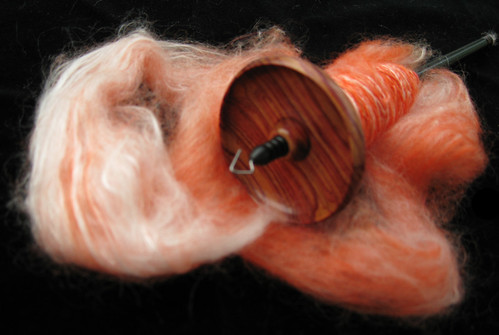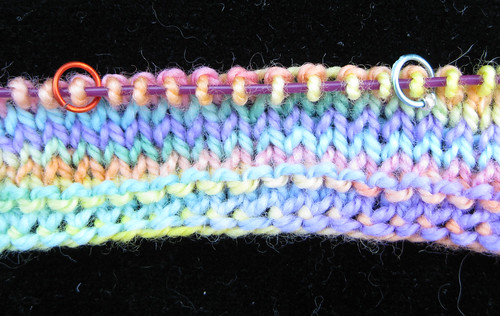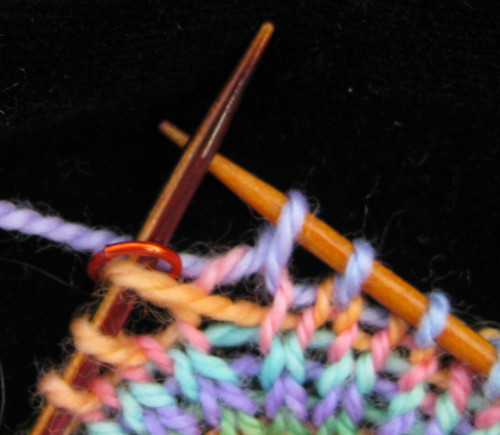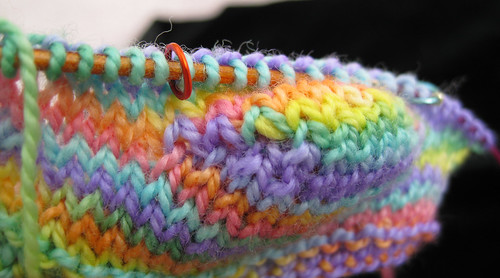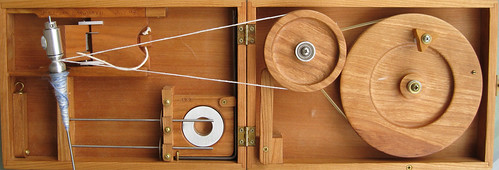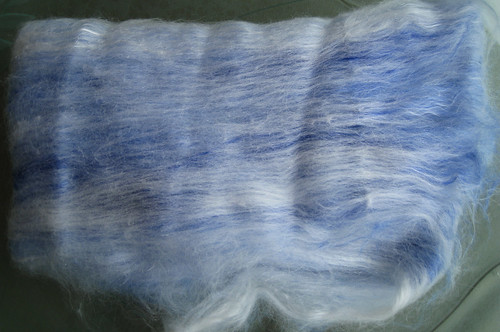A few posts back, I mentioned a test-knit that I was doing for a designer. I fearlessly quote my own blog post below, as I wrote it and gave myself written permission to quote it elsewhere under the Fair Use provision of copyright law. The excerpt is fewer than 50 words, so I should be doubly safe from self-litigation.
... a test knit so hideous that Laptop scuttles out of the room (hissing) whenever I remove the thing from its lightproof bag. To add insult to injury, the supplied yarn's texture rivals that of steel wool, but is not quite as soft.
Having placated the copyright cops, I state here, for the comfort of the FTC, that both the pattern and the yarn were given to me. However, neither were gifts, as I must return both the knitted object and the remaining yarn to the designer, for which I will be paid a pittance. I did, however, receive a free copy of the pattern, and this I shall gleefully burn. Aside from the appearance of the thing, which Harry and I agree is the single ugliest knitted work in the history of textiles, the pattern contains several errors. The designer did not respond to my queries, so I assume that the errors are now written in stone printer's ink.
It turns out that the pattern is from a book the designer has written, as I discovered on Saturday. I picked up a book at SAFF, and was smacked in the eye by The Ugly Object as I riffled through the pages. It occurred to me that I ought to do a book review, since I have an intimate acquaintance with at least one of the patterns contained therein.
I am not, however, going to mention either the book title or the author, lest I be sued for libel. Similarly, I will not be showing you any photographs or quoting content, for fear of breaking copyright law. I am safe from the FTC as well, because I neither bought, nor received the book as a gift, so do not now, nor have I ever, had it in my possession.
So, I present to you an FTC/Litigation/Copyright-Safe Book Review. Please feel free to reuse the words here for your own book review. As you will see, my coverage will work for just about any knitting book you dislike, while keeping you out of the courts and the prison system! Furthermore, I give everyone blanket permission to blatantly copy everything written below in perpetuity.
Fleegle's Hard-Hitting Review of , by , available from , 2009.
The title of this book is very descriptive of the contents, but the designer's taste leaves something to be desired. I've never seen anything quite like these finished objects, which are actually not intrinsically ugly. However, the designer's choices of yarn and color transformed the plebeian patterns into a chaotic visual jumble.
The body text font is a very thin, condensed typeface, making it difficult to read and even more difficult to follow the directions. The color plates, paper, and binding are very attractive. Nice job, printers!
The book has a table of contents, an index, and a bunch of designs in between. I won't tell you how many there are, because you might figure out which book I am talking about and notify the designer. In turn, the designer would contact a lawyer and I would be sued for libel. Let's just say that there are more than five and fewer than 100.
I noted that most of the patterns could be found for free on Ravelry, and would most definitely benefit from your own personal and tasteful choice of color and yarn. I am not going to tell you what kinds of patterns we are talking about, because again, you might guess the book and I would be sued. The patterns are definitely all knitted, most with worsted weight yarn. Some patterns were knitted with other yarns, but I am not going to furnish any more details, except to say that you will need some knitting needles to complete them. A few stitch markers would be a good idea, too.
So, to conclude, unless you are a fan of visual hysteria, I discourage you from purchasing this book.
And with that, I leave you until next time, when I shall present photographs of an actual finished lacy sweater, knitted and photographed by me, and completed this very day.
Monday, October 26, 2009
An FTC/Litigation/Copyright-Safe Book Review
Posted by
fleegle
at
12:51 PM
26
comments
![]()
Labels: nonsense
Thursday, October 22, 2009
Mind Boggler of the Day
I rarely comment on news items, but these two blips are beyond ludicrous. The PRS is the British equivalent of the RIAA, who, we assume, will surely adopt these Draconian regulations in an effort to squeeze the last penny out of anyone dumb enough to hum in public.
PRS Threatens Woman For Playing Radio To Her Horses Without Paying A Licensing Fee
PRS's Latest Trick: Demanding Money From Shop Assistant Who Was Singing At Work
Posted by
fleegle
at
10:50 AM
10
comments
![]()
Labels: nonsense
Friday, October 16, 2009
More Wickedness
A while back, I posted a pattern link to this lovely shawl (Something Wicked This Way Comes, by Karen Walker).
Although I love the red, I know that I would be bored to tears knitting miles of it, and this shawl is BIG. And it seemed to me that Something Wicked needed Something Black...the most wicked of colors. I begin a thought process.......
......Time passes. Aliens come and go in the back yard. Harry assassinates karaoke from Albania to Zanzibar. The RIAA sends Al Jolsen a copyright infringement notice. The FDA issues a recall notice on water (too much water will cause people to explode and that's not acceptable). Blue Cross/Blue Shield announces that having been born is a now considered a pre-existing condition and will no longer cover any illness or injury for any claimant who has undergone this process........
.......I think about knitting the edging in black. Nah. Too abrupt. Then I think about dip-dying it. Nah. Too chancy. Then I think about spinning the yarn and new possibilities present themselves. I finally emailed Anna at Corgi Hill Farm, sent her a picture of the shawl, and explained what I was looking to do. She's brilliant, folks. She carefully dyed a graduated series of silk/merino batts for me that will, after I spin it all up, give me a nice flow from Wicked Red to Wicked Black.
I have about 7 ounces of batt, and need about 2200 yards of two-ply, which works out to 314x2=628 yards per ounce. And that, after consulting various tables, is about 80 WPI. Doable, but it's going to take some time.
So the only Wickedness you're going to see around here for a while is Harry. Apparently, he had a nice gig at the Two Tables Restaurant in Zanzibar City. Unfortunately, a two-table audience was way too small for his ego, so he's taken some time off to kayak the Zambesi river. The guides discovered on his first day that Harry's rendition of Moon River caused crocodiles, algae, and hippos to flee from the river at Mach 2. The tour company is trying to sign him to a long-term contract. I personally wrote him a stellar letter of recommendation.
Posted by
fleegle
at
7:28 PM
29
comments
![]()
Labels: batts, Corgi Hill Farm Something Wicked, Knitting, lace, shawl, spinning spin
Tuesday, October 6, 2009
Terrible Tuesday
It has not been the best of days. The early morning hours were spent writing begging, whining eloquent, pursuasive letters to an assortment of accounting departments that owe me back pay.
Having completed this distasteful task, I moved on to the Project of the Day, namely a test knit so hideous that Laptop scuttles out of the room (hissing) whenever I remove the thing from its lightproof bag. To add insult to injury, the supplied yarn's texture rivals that of steel wool, but is not quite as soft.
I unpacked the magenta, yellow, orange, turquoise, and black yarns, donned my sunglasses and Kevlar gloves, and knit two rows (actually I knit one row and purled one row) of the convoluted, confusing directions painstakingly deciphered from the blurry scan of tightly packed, faint type.
Whoops. I am instructed to attach C, then knit some rows with D and F. Except why did I attach C? Removes sunglasses and gloves, emails the designer. Replaces project into lightproof bag and stuffs into closet.
Moving on to the Alternate Project of the Day, I unpacked the printer I was asked to review for a World Famous Techie Magazine. Too bad paper and ink cartridges were not supplied. Poked at the buttons for a few minutes and discovered that the printer has the unfortunate feature of Speech. Does anyone want a talking printer? After listening for a few minutes (Hi! My name is Phil and I'll be your printer today!), I resisted the urge to shoot the little elecronic creep in the USB port and began the Alternate Alternate Project of the Day.
Fortunately, this project actually went quite smoothly after the initial cast-ons, which featured long tails that were too short. I see from the pattern that I need 200 yards of yarn. I have 198 yards. What are the odds of having enough yarn for the last row?
Find out next time, because I am afraid to fire up the camera. It can talk to the printer.
Posted by
fleegle
at
1:04 PM
19
comments
![]()
Labels: nonsense
Tuesday, September 15, 2009
Current Knitting (and Spinning)
King Bat Shawl
I slogged my way to the finish line of the shawl body a few days ago. As you might imagine, I am very tired of pink. I have miles of edging to knit on before the thing is completed, but I am putting it aside for a while to let my Pink Receptors recover from extended stimulation. Cindersall's reversal of the crown motif was masterful, and I think it looks better than the original.
Honeysuckle Shawl/Sweater
Having carefully placed the Bat shawl on the bottom of my UFO pile, I decided to treat myself with my rendition of the Honeysuckle shawl/sweater thing, which appeared in Issue #6 of The Knitter.
This design is beautiful--elegant, graceful, and feminine. I had to read the directions four times because I simply couldn't believe that the designer would actually take a round shawl and convert it to flat knitting. Thus, the reader is instructed to knit across the pattern row, turn, purl back, and then, when the piece is finished, sew up the back seam. Nah. I am knitting it in the round like a grown-up.
For the sleeves, the original design calls for casting off 40 stitches one one row and then casting on 40 stitches in the next row. The sleeves are knitted separately and then sewn into the gap. Why make an ugly seamline at the shoulder and force the knitter to do even more sewing? Instead, I will knit a contrasting piece of yarn over 40 stitches. When I am ready to do the sleeve, I will carefully undo the contrasting yarn, pick up the stitches around the armhole, and knit the sleeves from the top down to the wrist.
In an incredible display of foresight, I decided to bead only the sleeves and the front side of the sweater. I realized that if I beaded the entire thing, I would wear the sweater once, wonder why my back felt like llittle glass beads were digging into it, slap my forehead, and put the thing away forever.
I am using Hamanaka mohair/silk Parfait yarn and some pretty beads that have been languishing in the closet for a while. Harry finds the piece rather restful. Too restful. I have to shake him out of the thing every time I want to work on it.
Spinning
I love Corgi Hill batts. I love them to pieces. I want to make an entire room out of Corgi Hill batts and live there. While I am busy accumulating the raw materials for the Corgi Hill Extension, I actually spun some up. Here's a neat ball of Navajo-plied merino/silk:
It will probably become a scarf for Kyoko-san if Harry doesn't filch it and bury it in his stash drawer.
And here's what's currently on the spindle:
Saturday, September 5, 2009
The Fleegle Symmetrical Short Row--No Wraps, No Holes, No Hassles
I've never been a fan of short rows, mainly because I've never been able to make them look pretty. I've tried all the techniques--yarn overs, Japanese, wrapped, unwrapped, rewrapped, and encroachment-- and frankly, they all look hideous. Or worse, one side looks nice and the other side looks hideous.
Every so often, I pick up my needles and fiddle around with short rows. But it wasn't until yesterday, as I was dozing in the car, that I came up with a new short row technique that actually looks attractive, is symmetrical, leaves no holes, and doesn't require wrapping or safety pins. Those familiar with the fleegle heel will find the concept similar. The only difference is that you are not spacing out the increases to make a gusset. You'll see what I mean when you work the sample (assuming, of course, that you have tried the fleegle heel).
If you want to try this out, I suggest you cast on 20 stitches. Knit a few rows and place markers around the center 10 stitches, because it will be between these two markers that we shall build a little nose. Note that all slipped stitches are slipped purlwise.
Here's what your row looks like at the beginning:
Knit across the 10 stitches between the markers. Put your needle through the bump behind the 11th stitch...
...and knit through the loop. You now have 11 stitches between the markers.
Turn. Slip the first stitch, which is your "new" stitch, and give it a little tug to tighten it up (important!). Before you proceed, please look carefully at the two stitches on the right needle. They are a pair under a single bump and the pair straddles the marker. I call it "1 pair."
Now purl 10.
Put your needle through the bump in the front of the 11th stitch...
...and purl through it.
You now have 12 stitches between the markers. Notice that you have made another pair of stitches under a single bump straddling the marker.
Turn, slip then first stitch, give it a little tug to tighten it up, and knit 9.
Put your needle through the bump behind the next stitch and knit it. You now have 13 stitches between the markers, and two pairs.
Continue on...
Turn, slip the first stitch, purl 8. Put your needle through the bump below the next stitch and purl it. 14 stitches are now between the markers and 2 pairs.
Turn, slip, knit 7. Pick up the bump in back and knit it (15 stitches between markers and 3 pairs).
Turn, slip the first stitch, purl 6. Pick up the bump in front of the stitch you just purled and purl it (16 stitches between markers and 3 pairs).
Turn, slip, knit 5. Pick up the bump in back and knit it (17stitches between markers and 4 pairs).
Turn, slip the first stitch, purl 4. Pick up the bump in front of the stitch you just purled and purl it (18 stitches between markers and 4 pairs).
Now we are ready for the second half of the short rows. The basic concept is that you will knit (or purl) one stitch further on each side by knitting (or purling) two stitches together. Do pull out the slack when knitting these. Otherwise, you'll have loose stitches that will make you sad.
Here is an annotated photo showing which stitches get knitted together.
Turn, slip the first stitch, knit 5, pull on the yarn to remove slack, knit 2 together.
Turn, slip 1, purl 6, purl 2 together or purl 2 together through back loops. I prefer the way P2tog looks, but you may like P2togtbl better.
Turn, slip the first stitch, pull on the yarn to remove slack, and knit 7. Note that the 7th stitch is the K2tog from the previous row. If you make a note of these decreases, you won't get confused as to how many stitches you should be knitting or purling plain. Knit 2 together.
Turn, slip 1, purl 8, P2tog.
Turn, slip the first stitch, knit 9. K2tog.
Turn, slip 1, purl 10, P2tog.
Turn, slip the first stitch, knit 11. K2tog. Do not turn.
Knit to the end of the row.
Turn. Purl 12 across the center markers, P2tog.
And here's what the left side should look like:
And the right side:
And the front (sorry, it's hard to photograph a nose):
Given this basic technique, many modifications are possible. You can use a different increase (knit front and back, for example). And you can change the directions of your decreases. Experiment and see what works best for you. If you have an improvement, do let me know!
Posted by
fleegle
at
5:03 PM
40
comments
![]()
Labels: short rows, tips
Sunday, August 30, 2009
Them's Fighting Words
I would guess that about 80% of the time, You Can Do That, although doing so might turn out to be expensive, awkward, or embarrassing. Or all three.
One of the biggest Can't Do That's around in Fiberland is the myth that you can't spin long fibers, such as silk and alpaca, on a charka. For those unfamilar with this device, it's basically a compact spinning wheel originally designed for spinning cotton. Closed, this size of this elegant machine is a bit smaller than a hard-backed book, hence its name book charka.
Spinners use charkas for other short fibers, such as cashmere and camel, but the First Law of Charkaness states that for longer fibers, You Can't Do That.
Having received this gorgeous cherrywood Bosworth charka as an early birthday gift, I dutifully spun the enclosed sample of mindnumbingly boring white cotton and then fooled around with some cashmere and camel. Okay, got the concept. Now on to the You Can't Do That fibers.
Out comes a lovely silk/merino batt from Corgi Hill Farms. These batts are not carded to homogeneity. Instead, the long, lush silk fibers are layered in between the beautifully dyed merino.
Contrary to expert opinions, not only can silk be spun on a charka, it spins beautifully with nary a blob.The stuff was just meant for long draw. It spins thick, it spins thin, it spins any way you like your yarn.
Here are some samples--medium, thin, and really thin.
And while we are busting myths, we might as well explode the Second Law of Charkaness: You Can't Spin Thick Yarn on a Charka. Sure you can, and here are some thicker samples to prove it:
Of course, the spindles on the Bosworth are small and delicate, so spinning yarn of this weight would fill them up in a few minutes. However, I have a Babe charka too, which sports a spindle fashioned from a nice, big knitting needle (courtesy of a fortuitous swap with Janice in Georgia). That spindle can hold almost as much as a clunker drop spindle. So there.
I figured I was on a roll, so I pulled out a one-ounce spindle and spun some gossamer laceweight from the batt. Current opinion is that you can't spin gossamer-weight on a spindle that heavy. I went up to the heaviest weight spindle I own, a 1.2 ouncer. And spun gossamer on that too.
All this, by the way, was accomplished in my round kitchen, which, when we requested this eccentric design from a herd of architects and builders, were told: "You Can't Do That."
Posted by
fleegle
at
3:35 PM
19
comments
![]()
Friday, August 21, 2009
We Interrupt This Blogcast for an Important Announcement

All of the yarns were custom-spun specifically for fine lace knitting--giving crisp-looking stitches, but blooming with a little halo after a wash-and-block. I hope to increase the number of custom yarns to eight or so. For now there is a lot of:
- Love Potion #3: 36/2 cobweb lace yarn; 35% cashmere, 35% silk, 30% merino
- Sheherazade 36/2 cobweb lace yarn: 50% camel, 30% cashmere, 20% merino
- 30/1 plying silk for spinners
- Folca boxes
Harry is working hard at adding other items and as soon as he returns from his karaoke bartending class, I'll make sure he uploads some more stuff.
I hope you at least enjoy looking at our shop. Of course, both of us would be especially delighted if you bought something, but I refuse to follow Harry's suggestion that I whine, wheedle and beg. Until later. If needed. Do take a peek and have fun!
Posted by
fleegle
at
12:25 PM
29
comments
![]()
Labels: The Gossamer Web
Saturday, August 15, 2009
Silly Season
Traditionally, silly season is the period starting in late summer, sometimes called the Dog Days of August. History tells us that this is the time when newspapers, lacking in substantive news, publish stories about three-headed watermelons, alien-infested knitting magazines, and sightings of purple fungi growing on Capitol Hill.
I don't have anything that exciting to report, although we did have a bear wander up to the back door in search of a snack. Who knew that bears could give you puppy-dog eyes? Being of sound mind, we did not open the screen door and toss out any bear kibble. Barnabas then proceeded to strip our fig tree of fruit and then wandered up the hill to have dessert at our neighbor's plum tree.
My personal silly season began with boredom. I have been working on two interminable projects--the King Bat shawl and the Iris stole. I am sick to death of both of them, but know that if I put them aside, they will slowly mutate from WIP to UFO. I have invested too much knitting time in these two objects to condemn them to UFOness.
So, in the spirit of Silly Season, I present Douglas, the Extremely Happy Giraffe.

This charming pattern, and may others equally adorable, are available for free from Bobbi Padgett. I have an urge to work the hippo, but haven't decided what color it should be. Pink and purple hippos are so common, gray is so dull, and green seems a little too peculiar.
Douglas here will become the personal pet of Nina, the daughter of a friend living in Japan. Let's wish him bon voyage and hope he enjoys sticky rice!
Posted by
fleegle
at
4:18 PM
24
comments
![]()
Saturday, August 1, 2009
A Rare Perfection
Spindles are much like sock yarn--there's always another one you have to try (at least for sock knitters) Other knitters might crave the next Noro colorway, brushed cashmere yarn, or the newest knitting needles fashioned from string beans. And non-knitters might yearn to acquire the complete works of Phillip Parker. As he has written over 200,000 books, that particular passion is even more profoundly time-consuming than spindle acquisition.
Anyway, having caught the spindle bug, I set out to test-drive spindles from a variety of craftspeople. I firmly believe that every quality spindle has a sweet spot in terms of fiber and yarn thickness. Some of my spindles are still in the drawer, awaiting their perfect mate. But of the eight spindles I now own, two spindles stand out as the epitome of perfection.
They are exquisitely made, perfectly balanced, beautiful to look at from all angles, and simply wonderful to use for a variety of different fibers.And I shall tell you about them another time.
Just kidding.
These two stunning beauties are from Spindlewood. The left whorl is camphorwood (smells spicy!), and the right whorl is bloodwood. They both weigh about 18 grams. Now take a look at the lovely workmanship on the shafts. The ebony shaft on top goes perfectly with the bloodwood; the flamewood shaft on the bottom makes a lovely foil for the camphorwood.
The ebony shaft on top goes perfectly with the bloodwood; the flamewood shaft on the bottom makes a lovely foil for the camphorwood.
The camphorwood is now Number One in my Spindle Hall of Fame. Because of the perfect weight ratio between the shaft and the whorl, it feels much lighter than 18 grams and spins gossamer weight with grace.
Customer service is perfection too. During the creation process, Connie emailed me pictures of the whorls, then pictures of the shafts. When I asked for a darker shaft wood for the camphorwood, they graciously made me another spindle. And the spindle comes with a cover for the hook--a clever little touch.
And Then There Is The Golding...
The front of this spindle has a sweet and charming face made from a Russian brooch I found on eBay. I sent it off to Tom Golding with a request that the spindle be made as light as possible. I also emailed, phoned, and lettered him about my personal dislike of walnut. No walnut. No walnut. Please, no walnut.
I sent it off to Tom Golding with a request that the spindle be made as light as possible. I also emailed, phoned, and lettered him about my personal dislike of walnut. No walnut. No walnut. Please, no walnut.
I eagerly opened the package to find a 22-gram black walnut whorl and a walnut shaft. Hmm. As soon as the yarn comes off the spindle, I will dye it black with a juicy permanent marker. This little fix was recommended on several woodworking sites. I tried it on another spindle--the ink is permanent and even shows the grain.
It must be me, because the whorl so overbalances the unadorned shaft that the spindle wobbles like a drunken Klingon (and spins about as well). It works perfectly fine for plying, however, so I didn't return it (Tom will give you a refund if you aren't happy). I am sure there will be some fiber in the future that will happily spin on this spindle, but for now, it remains a disappointment.
Posted by
fleegle
at
12:13 PM
26
comments
![]()
Saturday, July 25, 2009
A Sticky Wicket
I am not the boss of much, but I am mostly the boss of this blog (except when Harry overrules me). And so today, instead of showing you knitted wares, I am going to tell a little story and ask you guys what you think of this practice:
An owner of a yarn store approached me last week, offering to supply me with yarn and let me do anything I wanted with it--knit cat hats, felt myself a mousepad, or just wind it around my ears. She would them pay me to post the review on my blog with a link to her store for those who wished to purchase the stuff.
I told her I might be interested, if, at the beginning of the review, I informed my readers I was being paid to fiddle with the yarn and say something about it. The owner did not like that idea at all. According to her, several Famous Bloggers, whose names she did not mention, are on the payroll of the biggest on-line store, which she again did not specify.Besides the fact that this practice is now illegal (see here), the entire concept makes me a little ill. I am not a Famous Blogger, but I think I would be doing my readers (however few) a disservice if I didn't reveal that I was being paid to talk about something. And certainly, I wouldn’t review the yarn at all if it were a nasty knit.
I find it sad that Famous Bloggers have become Greedy Bloggers. I may have been laid off and spend a lot of time inspecting the couch for spare quarters, but I don’t want to do anything that would compromise my innate honesty. Or am I just being naive and stupid?
What do you guys think?
Posted by
fleegle
at
1:58 PM
62
comments
![]()
Friday, July 17, 2009
On (and Off) the Silk Road
Harry takes great pride in his designs, as evidenced by the fact that he spent an entire evening slowly creeping around the King Bat shawl searching for flaws. Fortunately for me, he only found five cat hairs and a single decrease slanting in the wrong direction.
After a stern lecture to me about carelessness and to Laptop about feline hygiene, he departed (with 11 suitcases) for Uzbekistan. Apparently, the owners of the ALBATROS Karaoke Club in Tashkent had been incredibly impressed by his performance in Albania a few months ago and invited him for a two-day gig. In an effort to avoid an International Incident, I will not comment on the listening tastes of either Albanians or Uzbekistani.
Where was I? Oh yes. Harry. Uzbekistan. Eleven suitcases. The mystery of the suitcases was solved when Harry returned with 20 skeins of Z-twist 30/1 plying silk as a gift to my proto-store (it's taking shape, but it's taking time to take shape, sigh). I was immensely touched for a second...after which he demanded 75% of future profits, as well as my cashmere bathrobe. I guess we can all share.
I happened to have a spindle full of merino-cashmere waiting to be plied, so I immediately wound the silk and the yarn onto a felt ball and twisted the two strands together. Thank you, Harry! He may be an obnoxious, demanding spider with a penchant for sarcasm, aggrandizement, and chicken-fried raisins, but he has excellent taste in yarn.
As you can see, the silk and merino-cashmere are about the same weight, so the final yarn can safely be deemed 30/2. I have another spindle half-finished, but haven't made much of dent in the two-ounce bag of fiber yet.
And thanks to everyone's suggestions from the last post, I have indeed ordered a Golding. Actually, I ordered two--Harry wanted his own custom job. Tom Golding was understandably puzzled by my request for a .1-gram spindle, but after I explained, he decided that he could make a nice one out of a hand-painted pinhead and a hand-carved Japanese embroidery needle. Good luck with that, Tom.
Posted by
fleegle
at
8:20 PM
13
comments
![]()
Friday, July 10, 2009
Harry's King Bat--It's Alive!
When Harry first tossed me his redesigned border for the King Bat shawl, I was skeptical. After having knit this border section, I just laughed out loud. Who else could work bats and hearts into a Shetland ring shawl? Sharon Miller should never see this. I see a hoard of peasants out there warming up their pitchforks. Not good.
I am about 30% done with the border...from here on, except for the addition of another row of hearts, the border sort of mostly follows the original design. And I promise to be faithful to the edging, except where I might change it.
Current dilemmas revolve around whether to buy another Bosworth or veer off the well-trodden spindle path and get a Golding. I know I can't go wrong with a Bossie, but those Goldings are so lovely... I am sure there are plenty of opinions out there. Convince me.
Posted by
fleegle
at
2:07 PM
22
comments
![]()
Tuesday, June 23, 2009
The Blame Game
The blame for this post falls directly onto the shoulders of The Akamai Knitter and LaceFreak Jane. I refuse to accept any responsibility for my actions, because it's Not My Fault.
After observing (with tears in my eyes and lust in my heart) the spindle acquisitions of these two blameful beings, I was forced, much against my will, to order a 2" Karelian birch Bosworth spindle (about 18 grams) and two ounces of 80% merino, 20% cashmere from Miss Babs.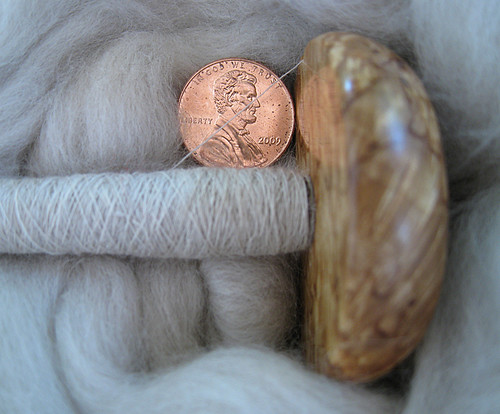
After a few false starts, due to the fact that I had never used a top whirler, I was happy to discover that spinning is like riding a bicycle. It didn't take long before I was humming along in my personal comfort zone of 80 wpi.
After a few days of spinning plain gray, my eyeballs itched for some color. A little red dye, a little fiber...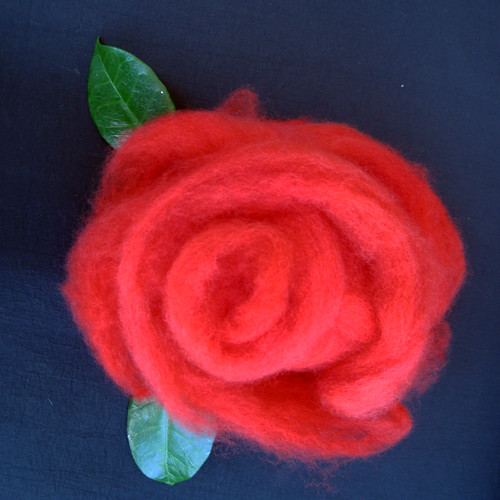
I also ordered a bit of angora/merino top from Susan's Spinning Bunny. In a remarkable display of postal schizophrenia, the package was both refused and signed for on the same day. Somehow, it was apparently refused here and returned to Susan, but when we looked up the tracking number, the post office said it was signed for and received on 6/18.
I questioned Harry closely about this, and the best explanation we have is that Harry answered the door, whereupon the mail carrier dropped her electronic gizmo, and ran screaming back to the car with the package. Harry carefully signed for the package by stomping on the gizmo's touch screen, and then wandered over to the hammock with a cold beer.
Meanwhile, after inhaling several tablets of Xanax, the postal carrier snuck back up to the front door, retrieved her gizmo, and then screeched out of the driveway with the package beside her.
If anyone has a better explanation, I would sure love to hear about it.
Posted by
fleegle
at
9:11 AM
26
comments
![]()
Wednesday, June 10, 2009
Purl Decreases Demystified
If you hunt around the Internet in search of purl decreases, you will probably encounter only two: the right-slanting single decrease (P2tog) and the right-slanting double decrease (P3tog). There may be times, however, when you need single or double left-slanting purl decreases or a double purl decrease with no slant at all.
Most commonly, you will encounter these snarky decreases if you are knitting garter-stitch lace in-the-round, for example, a borders-outward shawl in a single piece. To maintain garter stitch in the round, alternate rows must be purled (unless you are cheating and going to futz one corner so you can knit back and forth). And if you are knitting Shetland lace, there's probably no way you will escape having to work double purl decreases with no slant. Central double decreases abound in Shetland patterns.
After perusing my standard books, such as Barbara Walker's Charted Knitting Designs, and rejecting most of the solutions as kinda awkward, I fiddled around with a few different ways of accomplishing these dratted decreases. Some people hate purling through the back of stitches. Others don't find this uncomfortable. Please try all these methods and decide which one works best for you.
Left-Slanting Single Purl Decrease
The most common method is purling through the back of two stitches thusly: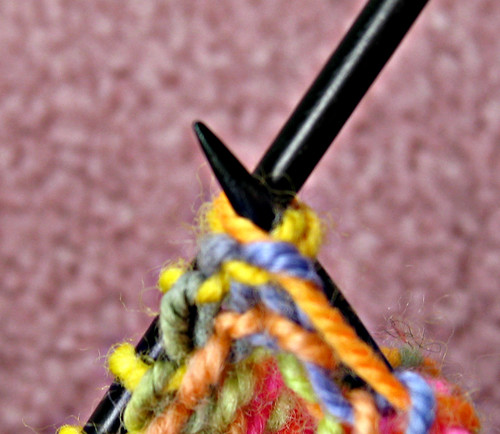
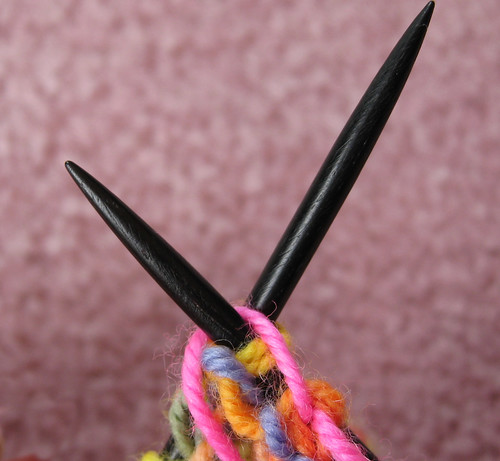
the finished stitch on the purl side:
And finished stitch on the knit side:
If you hate this process, then slip two stitches, one at a time, knitwise.
first stitch slipped...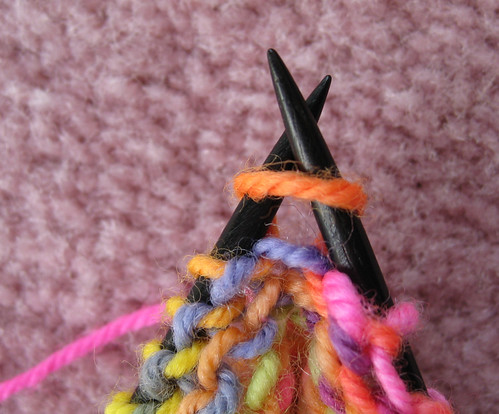
.... second stitch slipped.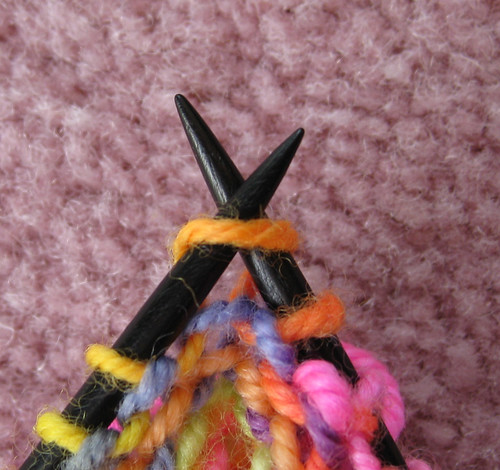
Then insert the tip of the left needle through the front of these two stitches (which are now on the right needle)...
and slip them back to the left needle as a unit. Notice that the stitches have switch positions.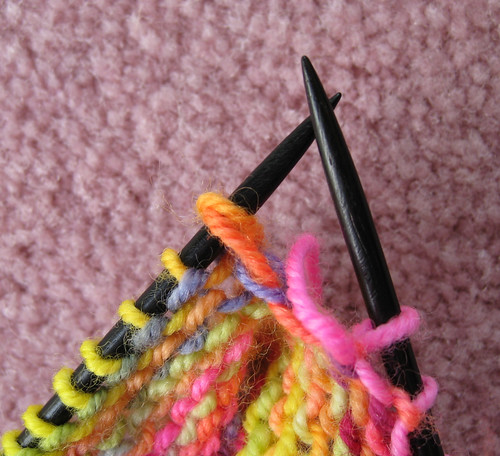
Purl these two stitches together.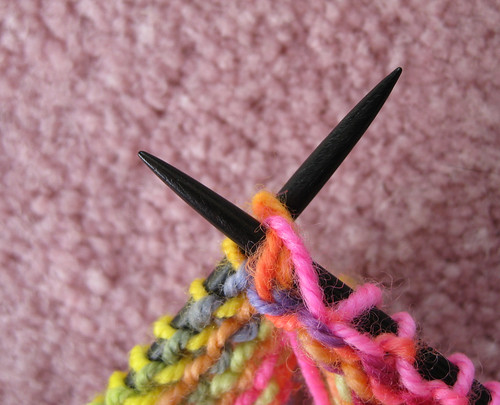
Here's the finished stitch on the purl side: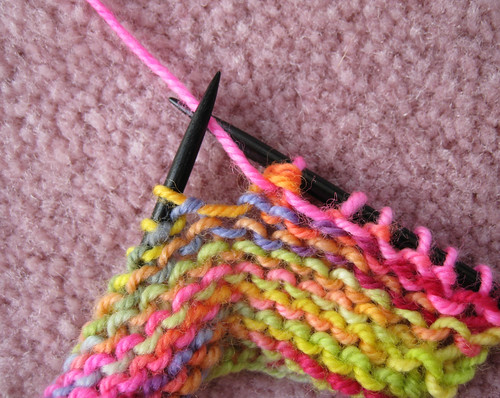
And here's the knit side:
The second method seems easier to me for purling together two stitches when one of them is a yarnover. But sometimes I just purl through the back. Which method I choose depends a great deal on the yarn--some yarns don't like the back stitch, some don't like the slip-and-flip business. Take your pick :)
Left-Slanting Double Purl Decrease
This is just an extension of the single decrease, but with added torment. No matter which method you use, the process is awful. My favorite method, not described here in detail, is to avoid patterns that require me to do this.
Anyway.
You can purl through the back of three stitches: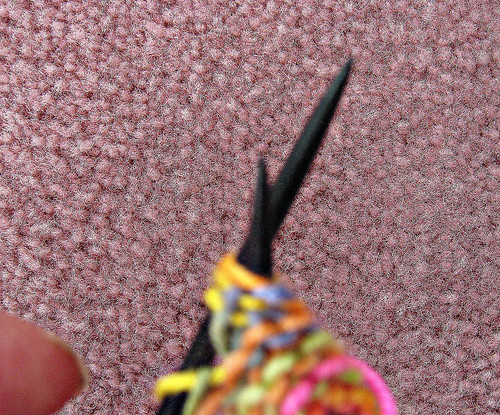

Here's what it looks like on the knit side:
Or, slip three stitches, one at a time, purlwise.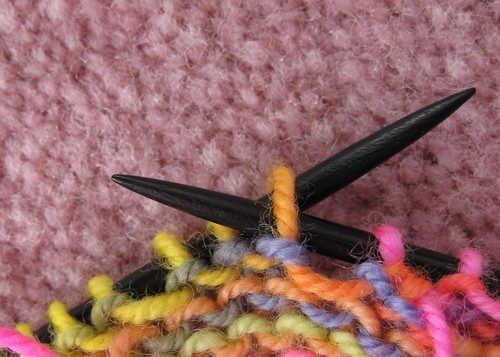
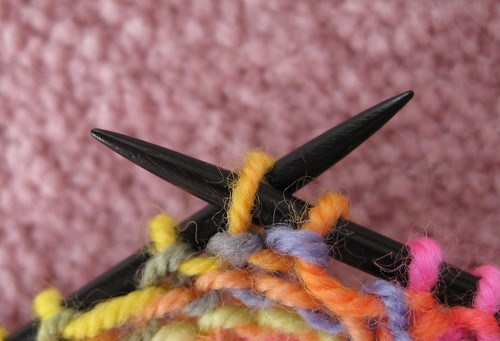

Then insert the tip of the left needle through the front of these three stitches (which are now on the right needle),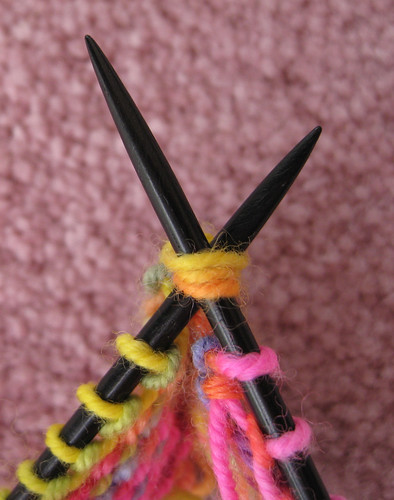
and slip them back to the left needle as a unit.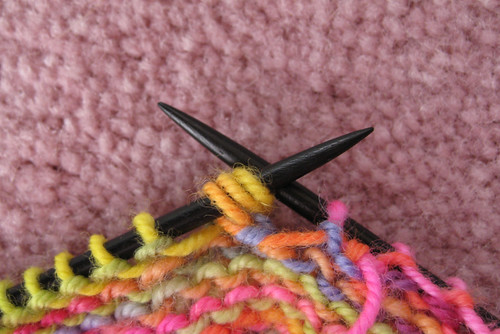
Then purl these three stitches together.
Here's the purl side: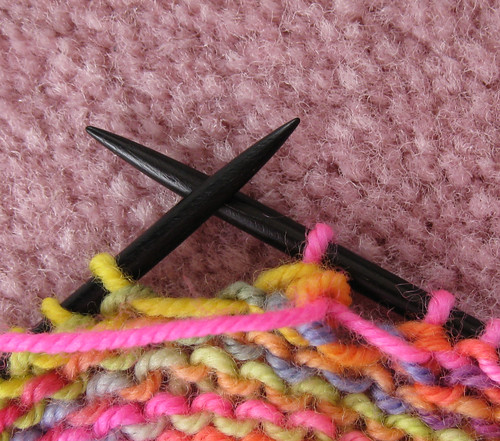
The he knit side looks the same as knitting 3 stitches together through the back loops as shown above, so I didn't take another photo.
Yet another method is described in the Walker book. Purl two stitches together. Keeping the yarn in front, put the stitch back on the left-hand needle. Pass the next stitch over this one, then transfer to the right-hand needle. I frankly don't care for the way it looks, but it's simpler to execute.
Double-Purl Decrease with No Slant (Central Double Purl Decrease)
This one is actually pretty easy. The literature I encountered had some wacky solutions; I think my answer is simpler. The first two steps are identical to the Left-Slanting Single Purl Decrease shown above.
Slip two stitches, one at a time, knitwise.
Then insert the tip of the left needle through the front of these two stitches (which are now on the right needle), and slip them back to the left needle as a unit.
Purl three stitches together (the two you slipped and flipped, plus one on the left-hand needle).
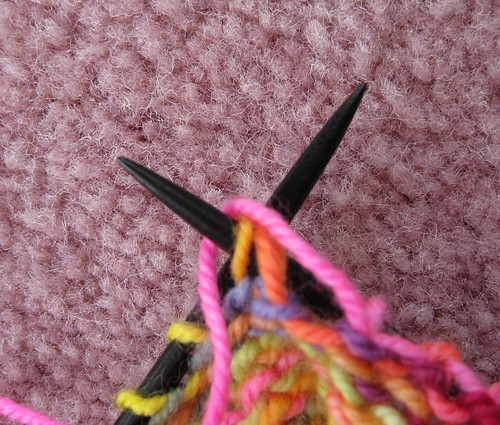
Here's the finished decrease on the purl side:
and the knit side: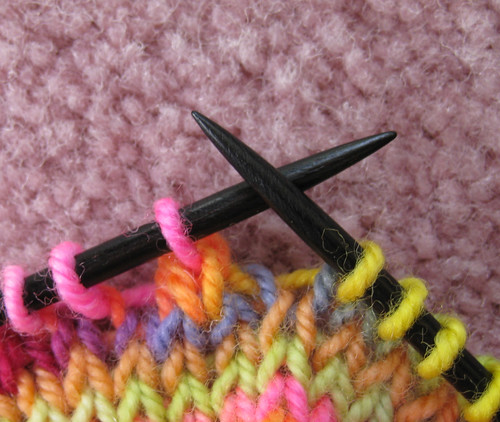
Posted by
fleegle
at
12:18 PM
22
comments
![]()





